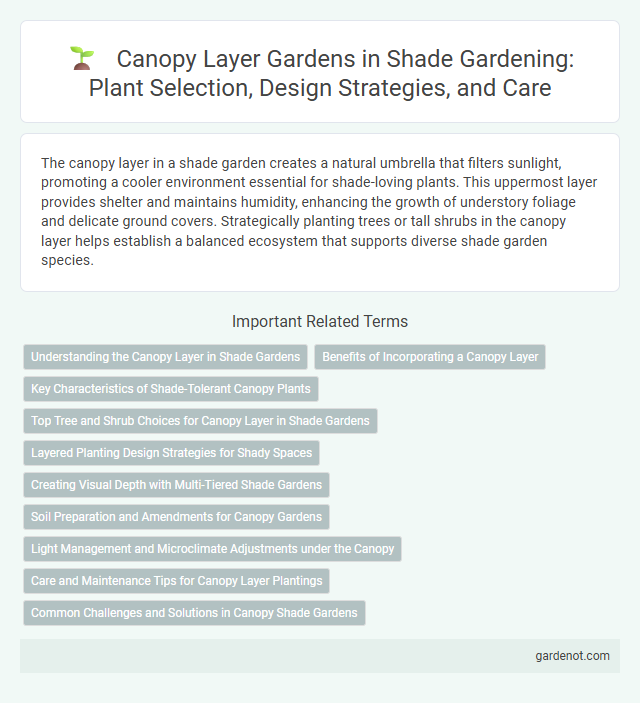The canopy layer in a shade garden creates a natural umbrella that filters sunlight, promoting a cooler environment essential for shade-loving plants. This uppermost layer provides shelter and maintains humidity, enhancing the growth of understory foliage and delicate ground covers. Strategically planting trees or tall shrubs in the canopy layer helps establish a balanced ecosystem that supports diverse shade garden species.
Understanding the Canopy Layer in Shade Gardens
The canopy layer in shade gardens consists of taller trees whose foliage creates a shaded environment underneath, crucial for supporting shade-tolerant plants. Understanding the canopy layer involves recognizing its role in moderating sunlight, temperature, and moisture levels, which directly influences plant selection and garden health. Proper management of canopy density enhances biodiversity and ensures optimal growth conditions for understory plants in shade gardens.
Benefits of Incorporating a Canopy Layer
Incorporating a canopy layer in a shade garden enhances biodiversity by providing shelter and habitat for various bird and insect species. This layer improves microclimate regulation, reducing soil temperature and moisture loss, which supports the growth of understory plants. The canopy also contributes to aesthetic depth and seasonal interest, creating a multi-dimensional garden design that thrives in low-light conditions.
Key Characteristics of Shade-Tolerant Canopy Plants
Shade-tolerant canopy plants thrive in low-light environments, often featuring broad, dark green leaves that maximize photosynthesis under limited sunlight. These plants exhibit slow growth rates and develop dense, layered foliage to efficiently capture diffused light. Common species include American beech, dogwood, and sugar maple, which contribute to forest understory protection and biodiversity.
Top Tree and Shrub Choices for Canopy Layer in Shade Gardens
Top tree selections for canopy layers in shade gardens include species such as Japanese Maple (Acer palmatum), Eastern Redbud (Cercis canadensis), and Serviceberry (Amelanchier spp.), which provide dappled shade and year-round visual interest. Shrub choices like Hydrangea quercifolia, Rhododendron spp., and Fatsia japonica thrive under these trees, contributing lush foliage and seasonal blooms that enhance shade garden aesthetics. Proper layering of canopy trees and shade-tolerant shrubs ensures a balanced microclimate, promoting biodiversity and healthy plant growth in shade garden landscapes.
Layered Planting Design Strategies for Shady Spaces
Layered planting design in shade gardens maximizes light capture by combining diverse heights and textures within the canopy layer, incorporating tall shade-tolerant trees such as Japanese maples and dogwoods. Understory shrubs like hydrangeas and azaleas enhance structural depth while optimizing dappled sunlight availability. Integrating groundcovers like ferns and hostas beneath these layers ensures efficient use of space and supports biodiversity in shaded environments.
Creating Visual Depth with Multi-Tiered Shade Gardens
A canopy layer garden enhances visual depth by incorporating multi-tiered plantings that mimic natural forest structures, using taller shade trees as the upper layer and understory shrubs and groundcovers below. Selecting diverse foliage textures and varying heights in shade-tolerant species like hostas, ferns, and Japanese maples creates dynamic spatial interest and a lush, layered effect. Effective layering in shade gardens not only maximizes vertical space but also supports biodiversity and microclimate regulation within the garden ecosystem.
Soil Preparation and Amendments for Canopy Gardens
Preparing soil for canopy layer shade gardens involves ensuring rich, well-draining soil with high organic matter content. Incorporate compost, aged leaf mold, and well-rotted manure to improve soil structure and nutrient availability, crucial for tree and large shrub roots. Regularly test soil pH and adjust with lime or sulfur to maintain a slightly acidic to neutral range (6.0-7.0) ideal for most canopy plants.
Light Management and Microclimate Adjustments under the Canopy
The canopy layer garden plays a crucial role in light management by filtering sunlight and creating dappled shade that supports shade-tolerant plants beneath. Microclimate adjustments under the canopy, such as reduced temperature fluctuations and increased humidity, promote a stable environment favorable for understory vegetation. Strategic selection of canopy species enhances airflow and soil moisture retention, optimizing growth conditions in shaded garden areas.
Care and Maintenance Tips for Canopy Layer Plantings
Canopy layer plantings thrive with regular pruning to remove dead or overcrowded branches, promoting healthy air circulation and light penetration essential for shade garden vitality. Consistent mulching conserves soil moisture, suppresses weeds, and improves nutrient retention, supporting the growth of shade-tolerant canopy species like maples and oaks. Monitoring for pests and diseases ensures early intervention, maintaining the structural integrity and aesthetic appeal of the canopy layer in diverse shade garden ecosystems.
Common Challenges and Solutions in Canopy Shade Gardens
Canopy shade gardens often face common challenges like limited sunlight, poor air circulation, and soil moisture imbalance, which can hinder plant growth and diversity. Solutions include selecting shade-tolerant plant species such as ferns, hostas, and heucheras, improving soil quality with organic mulch to retain moisture, and pruning canopy trees to enhance light penetration and airflow. Properly addressing these factors promotes a healthy understory ecosystem and vibrant garden aesthetic.
Canopy layer garden Infographic

 gardenot.com
gardenot.com